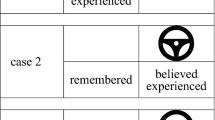Abstract
In The Blue Book, Wittgenstein defined a category of uses of “I” which he termed “I”-as-subject, contrasting them with “I”-as-object uses. The hallmark of this category is immunity to error through misidentification (IEM). This article extends Wittgenstein’s characterisation to the case of memory-judgments, discusses the significance of IEM for self-consciousness—developing the idea that having a first-person thought involves thinking about oneself in a distinctive way in which one cannot think of anyone or anything else—and refutes a common objection to the claim that memory-judgments exhibit IEM.
Similar content being viewed by others
References
Anscombe, G. E. M. (1981a). “The First Person” in her (1981), Collected philosophical papers Vol. II: Metaphysics and the philosophy of mind. Oxford: Blackwell.
Evans G. (1982) The varieties of reference. Clarendon Press, Oxford
Hamilton A. (1995) A new look at personal identity. Philosophical Quarterly 45(180): 332–349
Hamilton A. (2003) ‘Scottish Commonsense’ about memory: A defence of Thomas Reid’s direct knowledge account. Australasian Journal of Philosophy 81(2): 229–245
Hamilton, A. (2005). Proprioception as basic bodily knowledge. In R. van Woudenberg, R. Rood, & S. Roeser (Eds.), The epistemology of basic belief (pp. 269–291). Ontos Verlag.
Hamilton, A. (forthcoming). Memory and the body: A study of self-consciousness.
Hoerl C. (1999) Memory, amnesia and the past. Mind & Language 14: 227–251
Reid T. (1967) Philosophical works. Georg Olms, Hildesheim
Wittgenstein L. (1969) The blue and brown books. Blackwell, Oxford
Wright C. (1998) Self-knowledge: The Wittgensteinian legacy. In: Wright C., Smith B., Macdonald C.(eds) Knowing our own minds. Clarendon Press, Oxford
Author information
Authors and Affiliations
Corresponding author
Additional information
This article originates in the work on self-consciousness that I embarked on in the 1980s, when Crispin Wright supervised my PhD The Self and Self-Consciousness. His patient and inspiring supervision helped to form my philosophical outlook. Taking our cue from Elizabeth Anscombe’s “The First Person”, and Gareth Evans’ discussion of self-reference in The Varieties of Reference, we focussed on the phenomenon of immunity to error through misidentification (IEM), which I gradually realised is key to an understanding of self-consciousness. Crispin suggested the definition of IEM which I still use here. He has turned to the topic in print only briefly, in his article “Self-Knowledge: The Wittgensteinian Legacy”, where he looks at the fundamental question of the relation between IEM judgments and the broader category of avowals, on which I say something below. My main aim here, after delineating IEM as relating specifically to memory-judgments, is to refute a common objection to it, and to discuss the significance of IEM for self-consciousness.
Rights and permissions
About this article
Cite this article
Hamilton, A. Memory and self-consciousness: immunity to error through misidentification. Synthese 171, 409–417 (2009). https://doi.org/10.1007/s11229-008-9318-6
Received:
Accepted:
Published:
Issue Date:
DOI: https://doi.org/10.1007/s11229-008-9318-6



